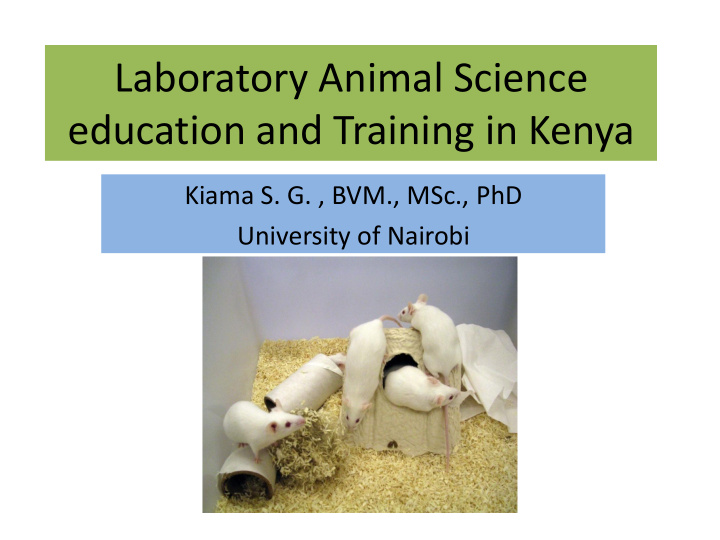



Laboratory Animal Science education and Training in Kenya Kiama S. G. , BVM., MSc., PhD University of Nairobi
Definition • Laboratory animal science is a multi-disciplinary branch of science, contributing to the humane use of animals in biomedical research. Animals are used for research in…. •Basic science •Regulatory toxicity testing •Drug development •Studies of Diseases
• There is at present no alternative to the living animal because….. • Each successive level of biological organisation has properties that cannot be predicted from knowing the lower levels of organisation
Ethical dilemma • While it is necessary to use lab animals in biological research, it is also necessary to protect the animals; a conflict between the two ethical demands
Laboratory Animal Science • The primary objective of laboratory animal science is • to contribute to quality of animal experimentation and the welfare of animals The most reliable results will be obtained from animals that are healthy, unstressed and content with their surroundings
Laboratory Animals, 1997
To conform to requirements • The International Council for Laboratory Animal Science (ICLAS) Working Group states that “ All personnel involved with the use of animals in research, testing and teaching should be adequately educated, trained and qualified in the principles of laboratory animal science and the ethical considerations of animal use, and should have demonstrable knowledge and expertise in the specific animal procedures proposed on the species to be used”.
• Chapter 360: The Prevention of Cruelty to Animals act (Laws of Kenya) • Part III, the performance of an experiment on an animal (section 13) • “a person, other than a licensee, who performs an experiment (on animals) shall be guilty of an offence and liable to a fine not exceeding three thousand shillings or to a term of imprisonment not exceeding six months or both”
• Further section 16 subsection 3 states “it shall be a condition of a licence granted under this section to a person who is not registered under the Veterinary Surgeons Act or the Medical Practitioners and Dentist Act that any experiment performed pursuant to the licence shall be performed under the supervision or direction of a person duly registered under one or other of those acts”
• According to Federation of European Laboratory Animal Science Association (FELASA) a scientist may be considered competent for the design or performance of animal experiments after having completed a graduate training in one of the biomedical disciplines ( e.g. Biology, medicine, veterinary medicine ) and, in addition, having taken a course in laboratory animal science for a minimum duration of 80 hrs.
Laboratory Animal Science • Education and training are needed to • provide the theoretical information and the hands-on experience • enable animal users to develop other attitudes and skills required to ensure the performance of high quality science with minimal animal suffering • establish a culture of care and provide assurance to the public that animal research is undertaken responsibly.
The training • The duration and/or intensity of the training program is be related to the severity and complexity of the procedures to be carried out on the animals and previous experience of trainees. • • Regardless of the duration of the educational and training experience or of the format, it is important to have some type of comprehension and skill assessment to ensure that the objectives of the education/training have been met. • Training held in University of Nairobi in Collaboration with Uppsala University: 2006,2007,2008 • Number of trainees: 76
Training in Kenya:FELASA Curriculum In collaboration with University of Uppsala 2006
2007 In collaboration with University of Uppsala
Laboratory animal science encompasses the following • The biology of laboratory animals • Their husbandry and environmental requirements • Genetic and microbiological standardization procedures • The optimization of experimental techniques • Recognition of pain and distress, the use of anesthetics, analgesics, tranquilizers and other palliative measures;
Course Content Continued • the importance of setting and implementing both scientific and humane endpoints as well as understanding the potential effects of both pain and distress and their treatments on science; • Ethical issues involving the use of animals in research, testing and teaching; • Search for alternatives to animal experiments
• Overview of pertinent laws, regulations and guidelines • Roles and responsibilities of ethical review committee, animal user, • Principles of the Three Rs (replacement, reduction and refinement); • Principles of occupational health and safety when working with animals.
Way forward • Education and training should be offered to the scientist and technicians who do research on animals • This could be offered in form of continuing education or refresher courses • Frequency of training should ensure that all animal users have an opportunity to receive adequate training prior to commencement of research.
Continued • Flexibility and diversity of delivery systems/formats should be encouraged. • In addition to traditional lectures and workshop formats, web-based courses, small group discussions and mentored laboratory experience should be considered.
• Every researcher working with live animals needs to evaluate his experiments in ethical terms.
Do animal have rights?
Do animal have rights?
It is important for researchers to be trained and competent in the experimental procedures they will carry out, and know how their animals are likely to respond. Most importantly, scientific techniques should be continually reviewed and refined
Recommend
More recommend